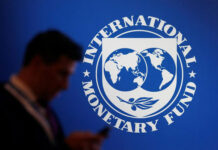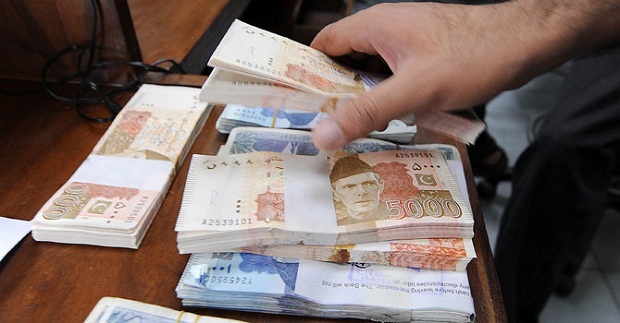Despite all efforts of the State Bank of Pakistan (SBP) to shrink the gap between the interbank and Kerb market rates, exchange companies are not ready to bring the US dollar’s rates down in open currency markets.
During the last week, exchange companies brought down only 70-80 paisas in the rate list while it is still being sold at 107.70 for buying and Rs 108.00 for selling on moneychanger’s counters.
Recently, the central bank gave a major incentive to exchange companies, exempting them from surrendering 10% of dollars to the banking system against its exports of other foreign currencies, as it (State Bank of Pakistan) wanted to reduce the gap of Rs 3.60 to only 50-70 paisas, but the incentive, private exchanges upheld their rates.
Countries like Pakistan, whose trade deficit has swelled up to approximately 140% against its major exports and a few millions of foreign direct investment (FDI), depends on its remittances to cover up the balance of payment that had already crossed $3.585 billion in the last six months.
An analyst of Topline brokerage house said, “We do not foresee any major adjustment in the Pak Rupee in 2017 on the back of expected CPEC inflows, which have already started to trickle in given tangible gains on the CPEC front.”
He further said, “There was stability in interbank rate during 2016, while a 3% devaluation may not be ruled out in the first half of 2017. This will be in line with our assumption of around 3% annual devaluation that can be expected in the next few years.”
“The rising current account deficit is also a concern,” the analyst said, adding that flow into the capital and financial accounts will balance the deficit in the current account
On the other hand, officials of the ministry of finance and the central bank totally rejected the devaluation of the Pak rupee in the current fiscal year claiming that the economy of the country is stable and they will not allow any devaluation of the currency.
“Remittances in exchange companies have come down by 50% in the last six months of the current fiscal year,” said Malik Bostan, President of the Pakistan Forex Association. “We can blame this shortage on the situation in the Middle East, but actually, we don’t know the reason, he added.
For the last few years, the country’s remittances were stable despite lower exports and FDI and this declining trend surfaced after a restructuring of property valuations on sale and purchase of land throughout the country. Overseas Pakistanis were sending their hard earned money back to Pakistan for the purchase of property and earning a profit, local builders claim.
Since July 2016, Pakistan’s key foreign currency exchange companies recorded a more than 50% drop in their transactions and are facing a shortage of dollars to meet the rising demand. Overall, there are 52 foreign exchange companies including A-category companies.
Most of the exchange companies say that nobody knows what is going on in the open currency market and that they are just following instructions of the association and their bosses to keep the exchange rate high.
Exchange Companies Association of Pakistan (ECAP) Secretary General Zafar Paracha said, “Money changers and exchange companies are facing a dearth of dollars because of the lower inflows and higher demands. In other words, we can say that foreign remittances of the Kerb market are drying up rapidly.”
“A major demand for dollars is coming from gold importers who are buying from Middle-East countries because of a price difference of Rs 3000-4000 compared to Pakistan,” he said adding that the other demand is from the local builders who are investing their money in Dubai’s construction projects, but it is difficult to say exactly where the money is being sent.
Giving the whole situation a new turn, market analysts are saying that after Brexit, the pound sterling and the euro have devalued, and Middle Eastern countries like Yemen, Iraq, Egypt, Syria and Saudi Arabia where 70-80% of overseas Pakistanis live, are in trouble because of a slowdown of their economies.
The money changers also confirmed this argument of the analysts, saying that they received fewer remittances from the Middle East countries in last six months than usual. “The inflow of pounds sterling and euros declined as their depreciation across the global markets discouraged overseas Pakistanis from sending remittances in these currencies,” Paracha said.
“In Pakistan, banks already handle the majority of foreign exchange transactions, while money changers have only 20-25% of the market share,” he added. “The government gives 7% incentives to banks on fetching remittances, but money changers have been deprived of the incentive,” he claimed.
In June 2016, the SBP issued new regulations for exchange companies, allowing them to export all foreign currencies other than the US dollar and to import dollars against these foreign currencies.
Foreign exchange companies are also bound to ask for the central bank’s approval for all outward remittance transactions of $50,000 or above (or equivalent in other currencies).
Despite this regulation, currency dealers said, our companies are not privileged to take dollars from banks to meet our demand.
An analyst said that exchange companies – especially from the ‘B’ category – face more stringent regulations by the central bank to check money laundering and terrorist financing. He further said that the SBP has kept the Pak rupee overvalued at Rs 104.85 (around 5-8%) while the IMF and other donor agencies had claimed that it should have depreciated.
He said that a slowdown in foreign inflows and currency smuggling had caused a shortage of dollars in the kerb market, widening the spread between interbank and kerb market rates.
The ECAP quoted the rupee in the range of 107.50 and 108.00 per dollar on Wednesday in kerb dealings, while in the interbank market the rupee traded at 104.80.
The Pak rupee, which was stable at 106 against the dollar over the past 15 months, quickly crossed the 109 mark in the open market during the last week of this month.
On the directive of the finance ministry, the Federal Investigation Agency (FIA) immigration cell further tightened security at airports, but was unable to find any irregularity.
An FIA immigration official said, “If a woman or girl enters Pakistan wearing gold bangles or earrings, whatever its value, we cannot stop or investigate them based on any law in Pakistan.”
“Around 20, 000 people are associated with illegal foreign exchanges in Karachi, Peshawar and Lahore,” a money changer said.
According to the currency experts, Karachi is the biggest city in terms of currency smuggling, while Peshawar, Quetta, and Lahore follow in that order. The gap in the rates of open and interbank markets has triggered hundi/hawala transactions. The difference in Kerb and Interbank markets is above Rs 3.60 but it has been stable in the open market for the last two weeks.
Dealers in the interbank market saw no change in the dollar rate due to the central bank’s intervention that did not allow the exchange rate to exceed Rs104.85. The central bank has record foreign exchange reserves despite a slowdown in remittances, fall in foreign direct investment, and wider trade and current account deficits.
Currency dealers were cautious about commenting on the hundi/hawala business. However, they noted that the illegal business is likely to show an uptick since the open-market rate is significantly higher than the official rate.
Pakistan received $1.824 billion in foreign investments (FI) from July-December 2016-17. The tally is 52.5% higher compared to same period in 2015. Foreign investments have been falling since 2008, but started improving last December.
Pakistan’s reserves which touched $24.2 billion in September 2016, now stand at $23.1 billion as the central bank faces a pressure of payments from the IMF and others donor agencies, and this pressure will likely increase when the SBP will begin payment instalments to the IMF from July 2017.
Rupee Performance:
In 2016, the Pakistani Rupee performed well in the interbank market. At the start of the new year, the dollar was valued at Rs 104.70 in the interbank market and the trading range for the year remained in a band of Rs 104.10 and Rs 105. Cheaper international oil reduced Pakistan import bill, keeping the rupee stable in the interbank foreign exchange market.
























